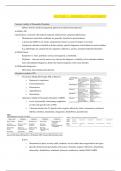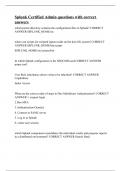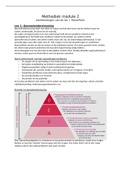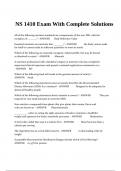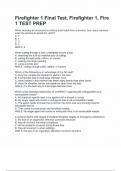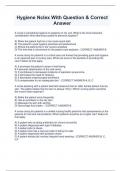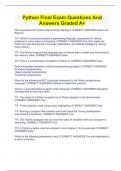LECTURE 5 – PERSONALITY ASSESSMENT
Construct validity of Personality Disorders
Debate: between medical/categorical approach and dimensional approach
à DSM-5-TR
Classification, consistent with medical treatment, dichotomous, categorical phenomena
- Dichotomous means that conditions are generally classified as present/absent.
- A person has MDD or not, binary categorization doesn’t account for degree of severity.
- Categorical, disorders classified as distinct entities, specific diagnostic criteria/labels for each condition
E.g. pathologies are categorized into categories, depressive, anxiety, neurodevelopmental disorders.
à DSM Criteria
- Symptoms vs. traits, polythetic criteria, heterogeneity, comorbidity.
- Polythetic – does not need to meet every criterion for diagnosis, variability in how disorder manifest,
more individualized diagnosis, distinct but related symptoms of the same disorder.
à Differential diagnostics
- Motivation, inter/intrapersonal dynamic
Alternative models of PD
- Five-Factor Model (FFM maps PD) or Big Five
o Openness to experience
o Conscientiousness
o Extraversion
o Agreeableness
o Neuroticism
- Alternative Model of Personality Disorders (AMPD)
o Level of personality functioning, emphasizes
severity and specific traits of PDs
o 5 domains broken into 25 specific traits: negative affectivity (traits: anxiousness, emotional
liability, hostility), detachment, antagonism, disinhibition, psychoticism.
- ICD-11
o Dimensional system, severity (mild, moderate, severe) rather than categorization into types
o Specific dysfunctional personality traits across 5 domains, negative affectivity, detachment,
dissociality, disinhibition, anankastic (obsessive tendencies), similar DSM5 AMPD.
, Personality Assessment for PD
à What are they?
- Written, oral and projective instruments, assessment will include:
o personal history, weakness/strengths, intelligence, defence mechanisms, attachment style,
coping styles, social abilities, childhood, traumatic experiences, cognitions, affects, emotion,
regulation styles, personality traits, environment, support system.
à Why conduct assessments for PD?
- Objective data on patients psychological functioning, help answering questions regarding treatment.
à Evidence-based practice in PD assessment
- Clinician can be biased by personal interest/bias, gender stereotypes, over/under diagnosis.
- What entrustment should we use then? There is no gold standard, not one instrument is 100% solid,
there is nonreliable validated clinical expert.
- Interpret the results of various instruments in combination with each other using multiple theoretical
frameworks.
à Recent developments in personality assessment
- Clinical value of DSM-V classification, underlying personality. dynamics, descriptive/categorical vs.
structural dynamic assessment, context.
- Need for performance-based measures though.
à Integrative psychodiagnostics, comprehensive approach in assessing PDs by evaluating these 6 domains:
Domain 1: Manifest pathology
o Objective/subjective patterns/symptoms/behaviours that indicate PD (impulse, emotional
stability, self-harm, detachment, antagonism).
o File research, clinical judgment, WAIS-V, SCID-5-PD, PID-5, UCL, SCL-90, BSI
Domain 2: social network/environment
o Social interactions, relationships, stressors, do they have support system?
o Clinical interview/hetero anamnesis
Domain 3: manifest cognitive schemas
o Deep-seated beliefs, cognitive patterns, assumptions, schemas.
o Implicit/explicit schemas, dominant theme of self, rigid, not adaptive, arise in childhoods,
conscious.
o Young Schema Questionnaire (YSQ), NPV-2
Domain 4: personality structure/ dynamics
o Not diagnosis but generating hypothesis about structural, underlying vulnerability of patient.
o MMPI-20RF (T/F response to items)/MMPI-3 (53 empirically validated scales), DSFM,
NVM, projective tests (thematic apperception test, house-
tree-person, sentence competence
Construct validity of Personality Disorders
Debate: between medical/categorical approach and dimensional approach
à DSM-5-TR
Classification, consistent with medical treatment, dichotomous, categorical phenomena
- Dichotomous means that conditions are generally classified as present/absent.
- A person has MDD or not, binary categorization doesn’t account for degree of severity.
- Categorical, disorders classified as distinct entities, specific diagnostic criteria/labels for each condition
E.g. pathologies are categorized into categories, depressive, anxiety, neurodevelopmental disorders.
à DSM Criteria
- Symptoms vs. traits, polythetic criteria, heterogeneity, comorbidity.
- Polythetic – does not need to meet every criterion for diagnosis, variability in how disorder manifest,
more individualized diagnosis, distinct but related symptoms of the same disorder.
à Differential diagnostics
- Motivation, inter/intrapersonal dynamic
Alternative models of PD
- Five-Factor Model (FFM maps PD) or Big Five
o Openness to experience
o Conscientiousness
o Extraversion
o Agreeableness
o Neuroticism
- Alternative Model of Personality Disorders (AMPD)
o Level of personality functioning, emphasizes
severity and specific traits of PDs
o 5 domains broken into 25 specific traits: negative affectivity (traits: anxiousness, emotional
liability, hostility), detachment, antagonism, disinhibition, psychoticism.
- ICD-11
o Dimensional system, severity (mild, moderate, severe) rather than categorization into types
o Specific dysfunctional personality traits across 5 domains, negative affectivity, detachment,
dissociality, disinhibition, anankastic (obsessive tendencies), similar DSM5 AMPD.
, Personality Assessment for PD
à What are they?
- Written, oral and projective instruments, assessment will include:
o personal history, weakness/strengths, intelligence, defence mechanisms, attachment style,
coping styles, social abilities, childhood, traumatic experiences, cognitions, affects, emotion,
regulation styles, personality traits, environment, support system.
à Why conduct assessments for PD?
- Objective data on patients psychological functioning, help answering questions regarding treatment.
à Evidence-based practice in PD assessment
- Clinician can be biased by personal interest/bias, gender stereotypes, over/under diagnosis.
- What entrustment should we use then? There is no gold standard, not one instrument is 100% solid,
there is nonreliable validated clinical expert.
- Interpret the results of various instruments in combination with each other using multiple theoretical
frameworks.
à Recent developments in personality assessment
- Clinical value of DSM-V classification, underlying personality. dynamics, descriptive/categorical vs.
structural dynamic assessment, context.
- Need for performance-based measures though.
à Integrative psychodiagnostics, comprehensive approach in assessing PDs by evaluating these 6 domains:
Domain 1: Manifest pathology
o Objective/subjective patterns/symptoms/behaviours that indicate PD (impulse, emotional
stability, self-harm, detachment, antagonism).
o File research, clinical judgment, WAIS-V, SCID-5-PD, PID-5, UCL, SCL-90, BSI
Domain 2: social network/environment
o Social interactions, relationships, stressors, do they have support system?
o Clinical interview/hetero anamnesis
Domain 3: manifest cognitive schemas
o Deep-seated beliefs, cognitive patterns, assumptions, schemas.
o Implicit/explicit schemas, dominant theme of self, rigid, not adaptive, arise in childhoods,
conscious.
o Young Schema Questionnaire (YSQ), NPV-2
Domain 4: personality structure/ dynamics
o Not diagnosis but generating hypothesis about structural, underlying vulnerability of patient.
o MMPI-20RF (T/F response to items)/MMPI-3 (53 empirically validated scales), DSFM,
NVM, projective tests (thematic apperception test, house-
tree-person, sentence competence

